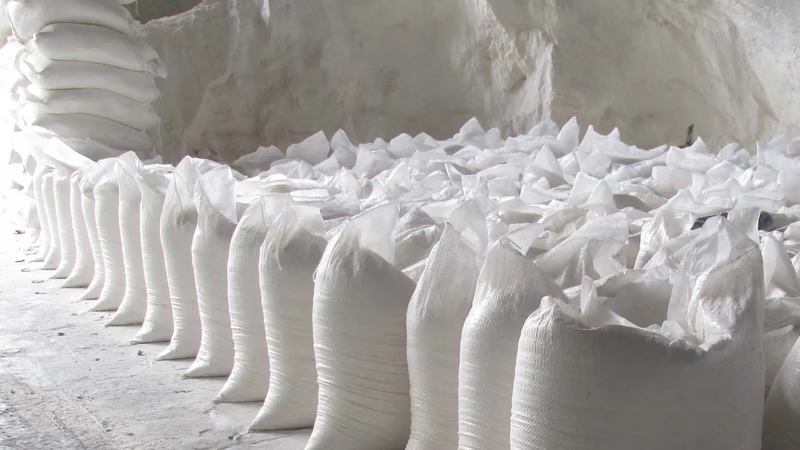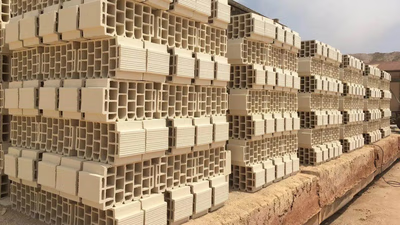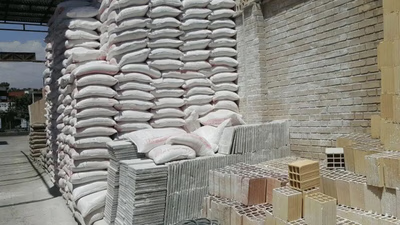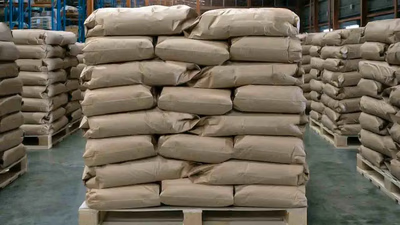
Gypsum plaster applications in construction and interior design.
Gypsum plaster is commonly applied as a smooth and durable finish for interior walls and ceilings. It provides a seamless and attractive surface that can be painted or decorated. Gypsum plaster offers excellent workability and can be easily applied in layers to achieve the desired thickness. Gypsum plaster is a key component of drywall systems, also known as plasterboard or gypsum board. Drywall consists of a gypsum core sandwiched between two layers of paper or fiberglass. It is used for constructing interior walls and partitions, providing fire resistance, sound insulation, and a smooth surface for further finishes.
Gypsum plaster is commonly used for repair and restoration work in buildings. It can be used to patch and level damaged surfaces, fill cracks, and restore the original appearance of historical or ornamental plasterwork. Gypsum plaster finds applications in various industrial sectors, including the production of molds for ceramics and dental casts, as well as in the manufacturing of gypsum-based products like plaster blocks, decorative tiles, and precast elements. Plaster is a soft, white powder obtained from Gypsum. This material is obtained directly from Plaster and no additives are used in its production. For information about the price of this product, refer to the price section of Construction Materials or plaster. The plasters used for construction purposes are as follows:
- Whitewash plaster: The price of whitewash plaster is very reasonable. This plaster is used to cover the surface and whitewash the walls, and its color is completely white.
- Micronized Plaster: This Plaster is produced from ordinary Plaster processing. Micronized Plaster is used for plastering, whitewashing and molding. In other words, it used for rendering, floating and finishing coats.
- Ivory Plaster: Ivory Plaster has a very fine granulation and its setting time is long. This material is used to kill the building and make prefabricated Plaster panels.
- Gipton Plaster: The adhesion of this type of Plaster is higher than other Plasters. This plaster can be applied on a variety of surfaces such as concrete blocks, foam surfaces and porous concrete surfaces.
- Siwa Plaster: This Plaster has good resistance to moisture and prevents heat and sound transfer. Siwa Plaster is obtained by combining micronized Plaster with other additives. This type of plaster is very suitable for underlayment. Plaster is one of the fast materials and it is used for making mortar, whitewashing the roof and walls of buildings, making prefabricated panels and decorative elements.
Gypsum plaster can be molded into various decorative shapes, such as cornices, ceiling roses, arches, and columns. These gypsum-based decorative elements add architectural detail and aesthetic appeal to interior spaces. Plaster skimming involves applying a thin layer of gypsum plaster over existing painted or plastered surfaces to achieve a smooth and uniform finish. It helps to conceal imperfections and prepare the surface for painting or wallpapering. Gypsum plaster is widely used in the construction of false ceilings, also known as suspended ceilings. These ceilings consist of a metal grid system that supports gypsum board panels. Gypsum plaster is applied to the panels, providing a seamless and visually pleasing ceiling that conceals services like electrical wiring, HVAC ducts, and lighting fixtures.
Gypsum plaster can be used as an acoustic treatment for walls and ceilings. By applying gypsum-based acoustic plaster, sound reflections and echoes can be reduced, creating a more comfortable and acoustically balanced environment in spaces such as auditoriums, theaters, and recording studios. Gypsum plaster is inherently fire-resistant and can help improve the fire resistance of building elements. It is used to create fire-rated walls, partitions, and ceilings that can delay the spread of fire and provide additional evacuation time. Gypsum plaster can be mixed with lightweight aggregates or additives to improve its thermal insulation properties. This type of plaster is used in systems such as insulated plasterboards or gypsum-based thermal insulation boards.
-

Gypsum plaster is a versatile building material widely used for interior finishes, providing a smooth and durable surface for walls and ceilings. It is a key component of drywall systems, offering benefits such as fire resistance and sound insulation. Gypsum plaster is also essential in repair and restoration work, allowing for the patching and leveling of damaged surfaces. Various types of gypsum plaster, including whitewash, micronized, ivory, Gipton, and Siwa plaster, cater to different construction needs, from decorative elements to moisture resistance. Gypsum plaster can be molded into intricate shapes for architectural detailing and is commonly applied in plaster skimming to achieve a uniform finish. Additionally, it is utilized in the construction of false ceilings, concealing services while enhancing aesthetics. Gypsum plaster"s acoustic properties make it suitable for sound treatment in spaces like theaters and studios. Its inherent fire resistance contributes to building safety, enabling the creation of fire-rated structures. The adaptability of gypsum plaster, combined with its various formulations, makes it a crucial material in the Middle East"s construction industry, supporting both residential and commercial projects.
-

Construction sand is essential for concrete and mortar, forming a key part of the aggregate mix used in various construction projects. The rapid growth of the construction sector in West Asia has led to increased demand for sand, necessary for residential, commercial, and infrastructure developments. Countries like the UAE, Qatar, and Saudi Arabia have implemented strict quality standards for construction materials, including sand, to ensure durability and strength. However, local availability varies; some nations depend on imports due to limited natural sources. For instance, Dubai imports sand from Australia for land reclamation projects. Coastal countries like Bahrain and Qatar can source sand locally, but this raises environmental concerns such as coastal erosion. The extraction of sand from riverbeds and coastal areas can disrupt ecosystems and lead to stricter regulations. To address environmental impacts, alternative materials like recycled concrete aggregates and manufactured sand are being explored.
The prices of construction sand fluctuate based on availability, demand, and regulations, affecting overall construction costs. Sustainable sand management practices are being adopted in some West Asian countries to promote responsible sourcing and alternative materials, ensuring the construction industry can meet its needs without compromising the environment.
-

Concrete, steel, bricks, wood, and aggregates are essential materials in civil construction, each offering unique properties. Concrete, a mixture of cement, aggregates, and water, is favored for its strength and versatility. Steel is crucial for structural integrity, providing high strength and corrosion resistance. Bricks, made from clay or concrete, contribute to thermal insulation and aesthetics. Wood is valued for its renewability and insulation properties, while aggregates serve as fillers in various construction applications. Asphalt is used for paving, ensuring durability and smooth surfaces. Cement acts as a binding agent in concrete and mortar, while glass enhances natural light and aesthetics in buildings. Understanding these materials is vital for construction professionals to create durable structures.
The industry also sees innovations with new materials like bitumen membranes and plastic composites, which improve moisture resistance and insulation. Familiarity with both traditional and modern materials is essential for effective construction planning and execution.
-

The Middle East"s construction sector is thriving, fueled by urbanization, population growth, and ambitious development plans. Major cities like Dubai, Abu Dhabi, and Doha are undergoing extensive construction, including skyscrapers and infrastructure projects, driven by government investments aimed at economic diversification. The region"s hosting of mega-events, such as the Dubai Expo 2020 and FIFA World Cup 2022, has further increased demand for building materials. A notable trend is the shift towards sustainable construction practices, with a rising interest in eco-friendly materials and energy-efficient designs. The Middle East is a significant player in the global cement market, exporting millions of tons of clinker, with Iraq being the largest buyer. The building materials market in West Asia includes both locally produced and imported materials, with local production focusing on cement, steel, and ceramics. The competitive landscape features both local companies and international suppliers, catering to diverse material preferences influenced by regional regulations and economic conditions. Advanced construction technologies, such as 3D printing and modular construction, are being adopted to enhance efficiency. Investments in infrastructure development are also substantial, requiring a wide array of building materials, thus presenting lucrative opportunities for suppliers and manufacturers.
-

Cement is a crucial material in construction, with various types serving specific purposes. Ordinary Portland Cement (OPC) is the most widely used, suitable for general construction. Blended cements, like Pozzolanic Portland Cement (PPC), enhance durability and are ideal for aggressive environments. Rapid Hardening Cement is designed for projects requiring quick strength gain, while Sulphate Resistant Cement protects structures from sulfate attacks. High Alumina Cement offers heat resistance for high-temperature applications. Other types include Colored Cement for aesthetic finishes, Refractory Cement for extreme conditions, and Waterproofing Cement for moisture protection. Each type of cement is formulated to meet specific construction needs, ensuring structural integrity and longevity. The choice of cement impacts the overall performance of construction projects, making it essential for builders to understand the properties and applications of each type.
-

Clay is essential in construction, primarily for producing bricks and blocks. It is mixed with water, shaped, and fired to create durable materials. Clay bricks are favored for their thermal insulation and aesthetic appeal, making them ideal for load-bearing walls and facades. Traditional construction techniques like adobe and rammed earth utilize clay mixed with sand and organic fibers, resulting in sustainable structures with excellent thermal mass. Clay also serves as a plastering material, offering breathability and insulation for various surfaces. Additionally, clay roofing tiles are popular for their durability and weather resistance, particularly in hot climates. The soil"s composition, including clay"s fine grains, affects its construction properties. Clay"s ability to stabilize temperature in buildings enhances energy efficiency.
It is also used in drainage systems due to its corrosion resistance. Beyond construction, clay is utilized in landscaping and as a natural liner for landfills. Its thermal insulation properties are harnessed in lightweight clay blocks and aggregates. In geotechnical engineering, clay stabilizes soil and prevents erosion. Eco-friendly clay-based paints are emerging as alternatives to conventional options, promoting healthier indoor air quality. The versatility of clay in construction and landscaping highlights its importance in the Middle East"s trade landscape, particularly within B2B marketplaces focused on regional product listings and verified exporters.






